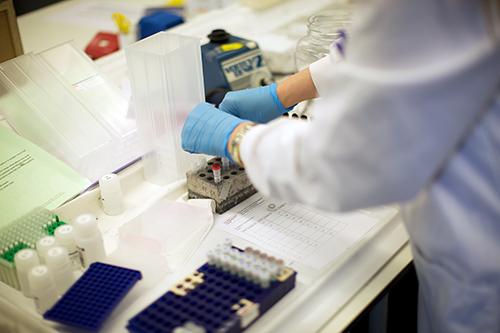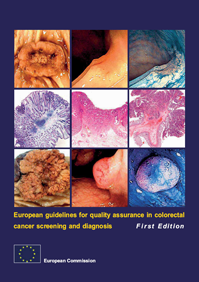Prevention and Screening
Prevention
According to the European Cancer Society, the top five recommended ways to help prevent colorectal cancer are:- Get screened for colorectal cancer regularly.
- Maintain a healthy weight throughout life.
- Adopt a physically active lifestyle.
- Consume a healthy diet with an emphasis on plant sources.
- Limit consumption of alcoholic beverages.
We have a new prevention and screening leaflet created for EuropaColon which has been translated into 20 languages.
These are available to download below.
These are available to download below.
EuropaColon Prevention Leaflet English
Portuguese
Dutch
Hebrew
Icelandic
Croatian�
What is screening and why is it important?
Screening is checking for health problems before they cause symptoms. The colorectal cancer (CRC) screening tests help to find polyps or cancer. Finding and removing polyps may prevent colorectal cancer, and colorectal cancer is generally more treatable and curable when it is found early, before it has had a chance to spread. This makes screening for colorectal cancer so powerful.There are different screening options available including optical inspection of the colon and rectum and specimen testing. The main screening methods are described below. To decide what screening option is right for you, please talk to your doctor.
� � � � � � � � � � � � � � � � � � � � � � � � � � � � � � � � � ��

OUTPATIENT PROCEDURES
| Screening Method | Procedure | Interval |
|---|---|---|
| Colonoscopy | During colonoscopy the doctor examines the inside of the rectum and entire colon using a long, lighted tube called a colonoscope. Colonoscopy is the most complete screening method available, allowing identification and removal of polyps in one session. Sedation may be given to patients to minimise discomfort. The procedure takes about 20 min and typically requires one day of clear liquids and laxative preparation. | Depending on the results of the examination patients need to be re-screened every 10 years. |
| CT colonography (virtual colonoscopy) | The CT colonography uses x-rays and computers to take 2- or 3-dimensional images of the colon and rectum of the patient. It is less invasive than a colonoscopy and usually does not require sedation, but a liquid diet and bowel preparation beforehand. Polyps cannot be removed during the screening process, means the patient will need to get a colonoscopy if the test is positive. This method is is becoming more widely available. | Patients should be re-screened every 5 years. |
| Flexible sigmoidoscopy | During flexible sigmoidoscopy the doctor examines the rectum and the lower part of the colon with a lighted tube called a sigmoidoscope. During this procedure, the upper section of the colon is not screened. Primary care providers can sometimes do the test in their office; it usually does not need sedation but still requires an enema preparation. It can detect polyps but cannot remove them during the procedure, instead a biopsy may be taken. If the biopsy is positive for colorectal cancer the patient will need to undergo colonoscopy. | Patients should be re-screened every 5 years. |
| Double-contrast barium enema | During double-contrast barium enema (DCBE) air and barium are pumped into the rectum. The solution will show any polyps or tumors on x-rays. It requires laxative preparation. If suspicious areas are seen on this test, a colonoscopy will be needed to explore them further. The availability of this test is decreasing, usually it is only offered to patients who cannot undergo colonoscopy. | Patients should be re-screened every 5-10 years |
| Digital rectal exam (DRE) | In this test the doctor examines the inside of the rectum with a gloved finger to feel for abnormalities. DRE allows examination of only the lower part of the rectum. Polyps usually cannot be identified during the exam. The patient will need to get a colonoscopy if abnormality is noted. | DRE is in some countries performed as part of a routine physical examination |
| Capsule endoscopy (CE) | With capsule endoscopy, a digital video camera with the size and shape of a pill is swallowed to visualise the gastrointestinal tract. It is usually used to examine the small intestine or esophagus. The procedure requires liquid diet and bowel preparation. This test is not widely available and is not as effective as colonoscopy in detecting polyps and cancer. | As this is a newer type of test, the best length of time to go between tests is not yet clear. |
SPECIMEN TESTING
With these tests a specimen of the patient, usually stool, is analysed in a laboratory, A positive test result indicates that the patient has an increased risk of having polyps or colorectal cancer. Follow up by colonoscopy is indicated to confirm the diagnosis.| Screening Method | Procedure | Interval |
|---|---|---|
| FOBT | The standard (guaiac) fecal occult blob (gFOB) test can detect small amounts of blood in the stool by using a small scrape from three consecutive bowel movements for testing. The test cannot identify polyps and some diet restrictions may be needed, as the test is not specific for human blood alone. gFOBT is used since more than 30 years in routine, is widely available and is inexpensive. If the test is positive, a colonoscopy will be needed to find the reason for the bleeding. | The test should be performed every two years. |
| FIT/iFOBT | The faecal immunochemical test (FIT) is more accurate and sensitive than gFOBT because it only identifies human blood and can do so at a much lower concentrations. Depending how this test is used, it can detect advanced polyps as well as cancers. FIT only needs one stool sample, although more samples can be used and is much simpler to complete. If the test is positive, a colonoscopy will be needed to find the reason for the bleeding. | The test should be performed once every two years. |
| Enzyme Biomarker M2-PK | The enzyme biomarker M2-PK has been identified as a key enzyme in colorectal cancers and polyps. M2-PK does not depend on blood in the stool and is specifically related to changes in the tumour metabolism. It does not require any special preparation prior to testing. Only a small stool sample is needed. M2-PK features a high sensitivity for colorectal cancer and polyps and is able to detect bleeding and non-bleeding colorectal cancer and polyps. In the event of a positive result you will be asked to undergo further examination e.g. colonoscopy. | The test should be performed once a year. |
| Enzyme Biomarker M2-PK + FIT/iFOBT (2in1 Quick) | A combined rapid test to simultaneously detect the enzyme biomarker M2-PK and haemoglobin (Hb). 2in1 Quick does not require any special preparation prior to testing. Only a small stool sample is needed. The test is able to detect bleeding and non- bleeding colorectal cancers and polyps. The strength of the 2in1 Quick test particularly lies in the fact that the enzyme biomarker M2-PK and human haemoglobin are very different biomarkers that are completely independent of one another. They each make their own contribution to colorectal cancer screening. The combination of the two biomarkers leads to a very high sensitivity for colorectal cancer and polyps. In the event of a positive result you will be asked to undergo further examination e.g. colonoscopy. | The test should be performed once a year. |
| Stool DNA tests | Stool DNA tests look for certain abnormal sections of DNA (genetic material) in a stool sample. The stool DNA test doesn't require any special preparation and is similar in performance than FIT, but requires an entire stool sample. This test is currently much more expensive than other forms of stool testing. | As this is a newer type of test, the best length of time to go between tests is not yet clear. |
NEW SCREENING METHODS
Besides the currently established tests, other methods have become available for CRC screening. The most important ones are capsule endoscopy and blood sampling.| Screening Method | Procedure | Interval |
|---|---|---|
| Capsule endoscopy | With capsule endoscopy, a digital video camera with the size and shape of a pill is swallowed to visualise the gastrointestinal tract. It is usually used to examine the small intestine or esophagus. The procedure requires liquid diet and bowel preparation. The method bears promise as an alternative to colonoscopy, because the examination can be realised without invasive intubation, sedation or radiation, but is not yet recommended in guidelines nor reimbursed for CRC screening. | As this is a newer type of test, the best length of time to go between tests is not yet clear. |
| Blood sampling | Another newer technology which has been developed uses a sample of blood to test for a molecular biomarker associated with colorectal cancer. A positive test result indicates that there is an increased likelihood of the presence of colorectal cancer. In the event of a positive result you will be asked to undergo further examination by colonoscopy. This test is believed to offer a suitable alternative to stool tests, but is not recommended in guidelines nor reimbursed yet. | As this is a newer type of test, the best length of time to go between tests is not yet clear. |
How to decide which colorectal cancer screening test(s) to use and how often to be screened?
You should talk with your doctor about when to begin screening for colorectal cancer, what tests to have, the benefits and risks of each test, and how often to schedule appointments.Your recommended colon cancer screening plan will depend upon your risk level of developing colorectal cancer, among other factors.
In general:
- All men and women should be screened for colorectal cancer beginning at age 50-55, if not earlier.
- People with personal or family history of colorectal cancer, inflammatory bowel disease, or are experiencing symptoms are considered increased risk* and should begin screening before age 50. Please discuss with your doctor.
- The frequency of screening depends on the method. See information on screening intervals above.
a) Family history of colorectal cancer
- People who have one first-degree relative (parent, brother, sister, or child) with colorectal cancer or adenomatous polyps at a young age (before the age of 60 years), or two first-degree relatives diagnosed at any age, should begin screening for colon cancer earlier, typically at age 40, or 10 years younger than the earliest diagnosis in their family, whichever comes first. Screening usually includes colonoscopy, which should be repeated every five years.
- People who have one first-degree relative (parent, brother, sister, or child) who has experienced colorectal cancer or adenomatous polyps at age 60 or later, or two or more second degree relatives (grandparent, aunt, uncle) with colorectal cancer should begin screening by colonoscopy at age 50, and screening should be repeated as for average risk people.
- People with a second-degree relative (grandparent, aunt, or uncle) or third-degree relative (great-grandparent or cousin) with colorectal cancer are considered to have an average risk of colorectal cancer
- Some people have known genetically-based colon cancer syndromes in their family, such as familial adenomatous polyposis (FAP) or hereditary nonpolyposis colon cancer (HNPCC). These less common conditions require aggressive screening and preventive treatments, and individuals with these conditions in their family should be managed by a clinician with clinical expertise in these syndromes.
b) Inflammatory bowel disease � People with ulcerative colitis or Crohn's disease have an increased risk of colon cancer. The best screening plan depends upon how much of the colon is affected and how long you have had the disease.

Note:
All details shown under this heading are provided by EuropaColon for the purposes of informing interested persons on the different methods available for screening for colorectal cancer.
These notes contain no direct or implicit observations or judgement on effectiveness, cost-effectiveness or appropriateness of methods and/or tests and EuropaColon suggests you contact your doctor for further information.
Access to any of the tests described will vary from location to location, depending on such factors as local availability, current health policy, cost factors etc and not all tests will automatically be funded by local public health insurance systems. It may be necessary therefore to pay on a private basis if you require having a test which is not publicly funded. Such aspects should also be discussed with your doctor and/or insurer.




-(2).png)
.png)



